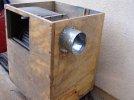Some hints on designing a filter for your shop....be it a grinder dust filter or a free-air filter.
Build the dust collector as two units/boxes. One is to move the air ( not actually to create a vacuum), and the other is to collect the debris.
Place the blower unit over the collection bin (Sealing the two as needed). Gravity will help your filter work better that way.
Put a removable bin in the collection chamber unit so you can remove the debris easily. If you make it so it fits the collector box fairly snug,you can put a large trash bag in it, and secure it in place with a bungee cord or similar band, you can easily remove the bag and place it in the trash. You can design the collector so the bottom is a trash can that can be detached. Look at some photos of the cyclone shop filters used for woodworking to get an idea of how this works so well.
Place the filter on the top of the debris bin, between the two units.
Place the inlet port six inches below the filter, with a baffle between it and the filters. This allows the debris to enter the collection chamber, and once in the lower pressure zone, the larger particles drop into the collection bin. The fines go to the filter.
If you just drew the shop air directly through the filter, it would be clogged in a very short time.
Now, I bet some have seen the obvious by now.....There is no reason the two units have to be in the same cabinet ( unless you want it that way). You can mount the noisy blower unit outside the wall in a little shed or box, and mount the debris bin inside the wall with a piece of 8-12" duct connecting the two. Try and keep them fairly close together. This setup will allow a larger (louder) blower to create more air flow. It also eliminates the need for HEPA filters, as any fines are ejected outside, not back into the shop air. HEPA filters are great, but clog up fast in a shop environment, and thus reduce the amount of air being filtered. If the air is being exited into a place where a little dust won't be a problem, no filter is needed at all. If it is going out into your side yard ( toward your neighbor) a plain filter between the air unit and the debris collector is a good idea. It should go without saying that the filter needs to be checked and cleaned/changed as needed.
If using the filter for grinding dust , put a good spark trap in the line. Place it as close to the grinder as practical. Make a spark killer filter to go on the exit side of the trap. The spark killer is just three or four pieces of screen mesh, or a balled up wad of screen, ( copper works best) that is a fail-safe to suck the heat from any stray spark that tried to pass through the trap.
The spark trap is about as simple a device as you can think of.
Get a small metal trash can and put an IN and OUT port flange on the top. Pop rivets and construction adhesive will do just fine. The IN port ( from the grinder) should go half the way down the can. The OUT port just sits on the lid. Place a sheet metal baffle that goes down to within 6" of the can bottom on the inside of the lid. This baffle should fit the sides fairly close. It should be at least 3" longer than the IN port tube. Place two channels on the can insides for the baffle to slide in on.
Use silicone caulk to make a seal on the inside of the lid. Put it on nice and thick to make a good gasket. A pair of latches to hold the lid down is all that is left to add.
Paint the inside of the can with several coats of epoxy paint. You can now put 2-3" of water in the can to quench the sparks without rusting out the can in a year. Dump the can and rinse it out weekly. Also,remember to check the water level before grinding, as it evaporates pretty fast in the high rate air flow. Adding a teaspoon of dish soap helps make it more efficient. If you want to get fancy, you can add a Plexiglas view-port on the side of the can. Just make a cut out and glue the acrylic in place with silicone sealant. This makes the water/debris level checking fast and easy.
One caveat about using an external blower, or exhausting the air outside, is that it will create negative air pressure in the shop unless you have a source of new air to replace that which is being drawn out. It can be as simple as raising the garage door a few inches, opening an outside door or window, or adding a suitable size louver with a screen ( to keep out insects) in the wall or eves.
One other benefit of venting the exhaust outside, is that it gives great air exchange, which keeps the air quality high in the shop.
Venting the air inside will keep the shop warmer in the winter, but at the cost of air quality.
In very cold climates, this is an issue you have to weigh - Warmer Shop ( tightly closed) means poorer air quality, or Colder Shop ( with air exchange) means safer and healthier air to breathe. In most of the USA, this is fixed by turning up the heat and wearing a vest. In Moosejaw, Sask., it can be a problem that needs to be considered.








